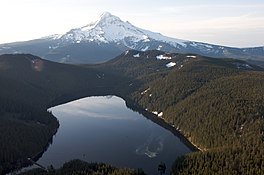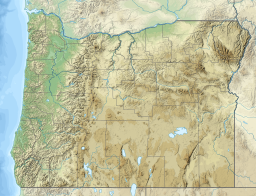Bull Run Lake is a reservoir, an impoundment of the Bull Run River in the U.S. state of Oregon.[1] Providing part of the primary drinking water supply for Portland, Oregon, it rates highly as an oligotrophic lake, a very clean source of water.[2] As of 1925, noted geographer Lewis A. McArthur described the lake as one of the two most important in the state (along with Crater Lake), supplying the drinking water for a third of the state's population.[3]
| Bull Run Lake | |
|---|---|
 Bull Run Lake and Mount Hood | |
| Location | Clackamas / Multnomah counties, Oregon, US |
| Coordinates | 45°27′21″N 121°49′49″W / 45.455951°N 121.830356°W |
| Type | reservoir |
| Primary inflows | Bull Run River |
| Primary outflows | Bull Run River |
| Catchment area | 3.5 sq mi (9.1 km2) |
| Basin countries | United States |
| Max. length | 1.5 mi (2.4 km) |
| Max. width | 0.5 mi (0.80 km) |
| Surface area | 466 acres (1.89 km2) |
| Average depth | 20 m (66 ft) |
| Max. depth | 70 m (230 ft) |
| Shore length1 | 4.2 mi (6.8 km) |
| Surface elevation | 3,162.8 feet (964.0 m) (Oct.) to 3,173.9 feet (967.4 m) (May) |
| Settlements | (none) |
| 1 Shore length is not a well-defined measure. | |
The lake basin receives more than 110 inches (2,800 mm) of rain annually due to its location in the Cascade Range, about 9 miles (14 km) west of Mount Hood. Public access to the area has been controlled since June 17, 1892, with the creation of the Bull Run Reserve by President Benjamin Harrison. Water from the reservoir first flowed into the Portland water system on January 2, 1895. President Theodore Roosevelt restricted entry to all but government agents and water company employees and banned stock grazing on April 28, 1904.[2]
In 1915 a new timber and rock fill dam raised the lake level about 10 feet (3.0 m). At least two series of efforts were made between 1917 and 1925 to decrease lake seepage. In 1961 additional areas of seepage were sealed with clay, and the outlet dam was remodeled to contain gates at elevations of 3,147 feet (959 m) and 3,158 feet (963 m).[2]
In 1994, concerns of outflow water temperature and its effect on fish populations led to regular careful measurements of the lake's thermocline characteristics and the inlet water temperature. Concrete pier blocks were installed to minimize the effect of water temperature shock on downstream aquatic life.[2]
Climate
edit| Climate data for Blazed Alder | |||||||||||||
|---|---|---|---|---|---|---|---|---|---|---|---|---|---|
| Month | Jan | Feb | Mar | Apr | May | Jun | Jul | Aug | Sep | Oct | Nov | Dec | Year |
| Record high °F (°C) | 68 (20) |
72 (22) |
74 (23) |
85 (29) |
92 (33) |
96 (36) |
100 (38) |
97 (36) |
95 (35) |
89 (32) |
74 (23) |
66 (19) |
100 (38) |
| Mean maximum °F (°C) | 55 (13) |
55 (13) |
60 (16) |
68 (20) |
76 (24) |
82 (28) |
88 (31) |
87 (31) |
83 (28) |
71 (22) |
59 (15) |
52 (11) |
89 (32) |
| Mean daily maximum °F (°C) | 38.2 (3.4) |
38.7 (3.7) |
42.6 (5.9) |
47.4 (8.6) |
54.4 (12.4) |
61.6 (16.4) |
70.9 (21.6) |
71.0 (21.7) |
64.0 (17.8) |
52.5 (11.4) |
41.6 (5.3) |
37.5 (3.1) |
51.7 (10.9) |
| Daily mean °F (°C) | 33.6 (0.9) |
33.6 (0.9) |
36.9 (2.7) |
40.4 (4.7) |
46.6 (8.1) |
52.4 (11.3) |
60.6 (15.9) |
60.9 (16.1) |
55.6 (13.1) |
46.3 (7.9) |
37.6 (3.1) |
32.9 (0.5) |
51.1 (10.6) |
| Mean daily minimum °F (°C) | 28.9 (−1.7) |
28.8 (−1.8) |
31.1 (−0.5) |
33.7 (0.9) |
39.1 (3.9) |
44.1 (6.7) |
50.4 (10.2) |
51.4 (10.8) |
47.6 (8.7) |
40.3 (4.6) |
33.1 (0.6) |
28.4 (−2.0) |
38.1 (3.4) |
| Mean minimum °F (°C) | 15 (−9) |
16 (−9) |
23 (−5) |
26 (−3) |
30 (−1) |
35 (2) |
41 (5) |
42 (6) |
37 (3) |
29 (−2) |
23 (−5) |
15 (−9) |
15 (−9) |
| Record low °F (°C) | −4 (−20) |
−1 (−18) |
11 (−12) |
20 (−7) |
20 (−7) |
27 (−3) |
35 (2) |
36 (2) |
30 (−1) |
15 (−9) |
7 (−14) |
−4 (−20) |
−4 (−20) |
| Average precipitation inches (mm) | 17.70 (450) |
13.17 (335) |
13.70 (348) |
10.86 (276) |
7.31 (186) |
5.78 (147) |
1.00 (25) |
1.66 (42) |
4.70 (119) |
11.62 (295) |
17.44 (443) |
19.27 (489) |
124.21 (3,155) |
| Average extreme snow depth inches (cm) | 65 (170) |
75 (190) |
88 (220) |
83 (210) |
56 (140) |
12 (30) |
0 (0) |
0 (0) |
0 (0) |
3 (7.6) |
19 (48) |
46 (120) |
88 (220) |
| Average precipitation days (≥ 0.01 in) | 20.9 | 17.7 | 21.5 | 18.9 | 13.7 | 10.4 | 3.7 | 4.5 | 7.7 | 15.2 | 19.5 | 21.0 | 174.7 |
| Source: NOAA[4] | |||||||||||||
See also
editReferences
edit- ^ "Bull Run Lake". Geographic Names Information System. United States Geological Survey, United States Department of the Interior. Retrieved 2011-06-21.
- ^ a b c d Roger Edwards (April 2002). "Bull Run Lake". Oregon Lakes Association. Archived from the original on 2008-08-25.
- ^ McArthur, Lewis A. (1925). . Oregon Historical Quarterly.
- ^ "NowData – NOAA Online Weather Data". National Oceanic and Atmospheric Administration. Retrieved 2012-07-20.

